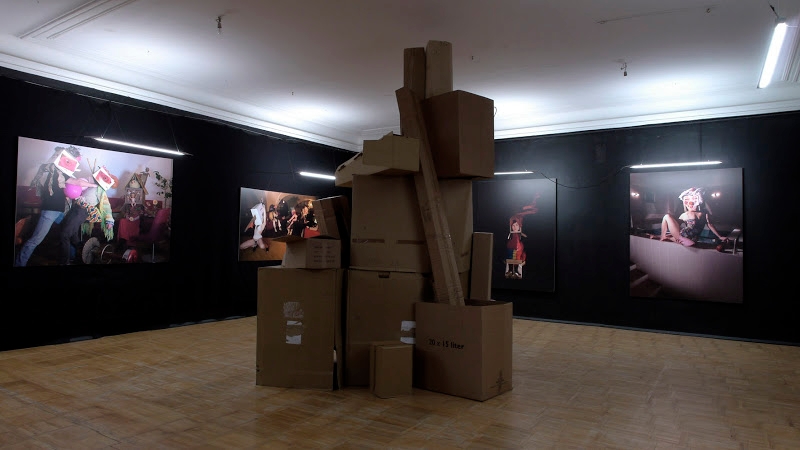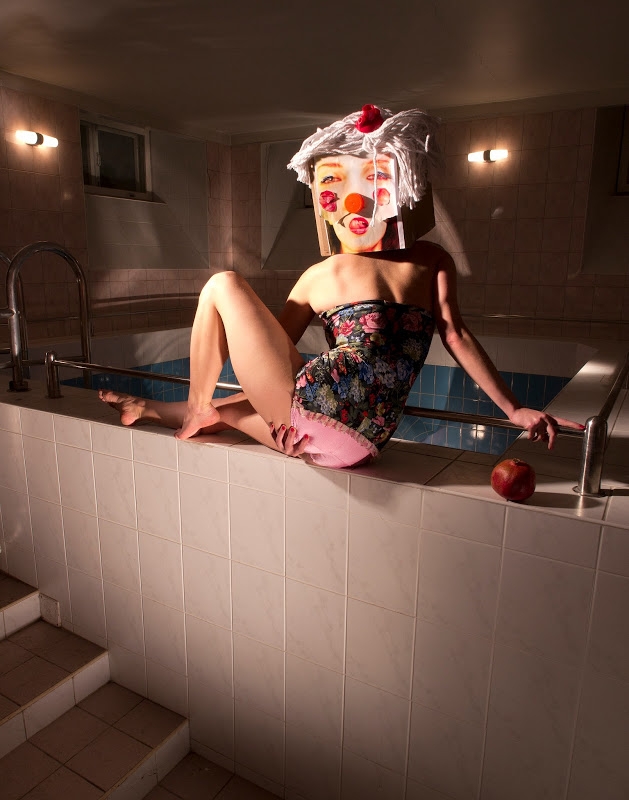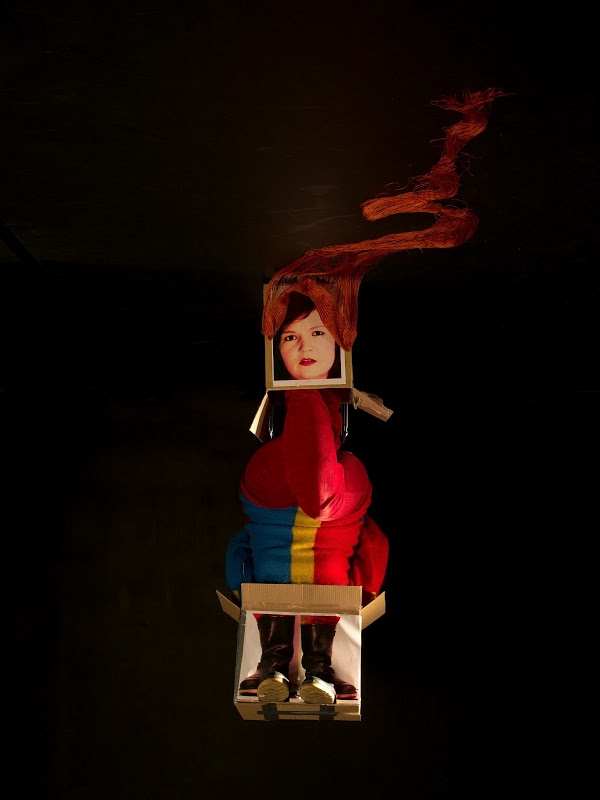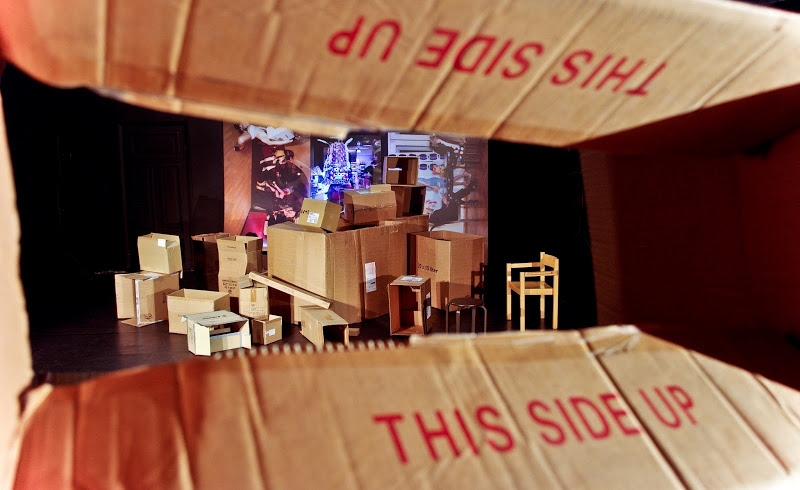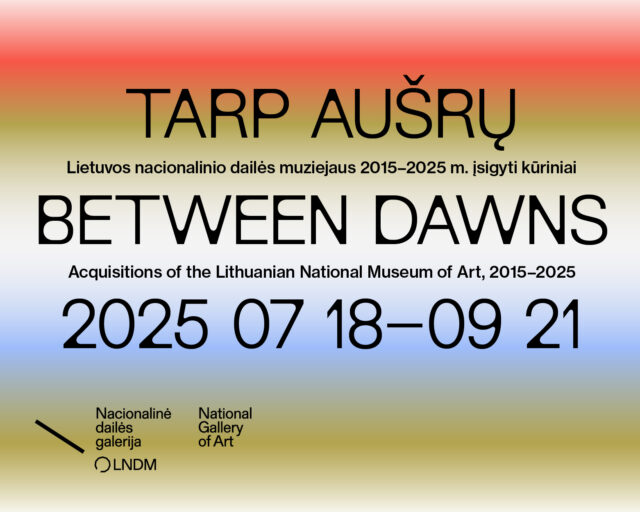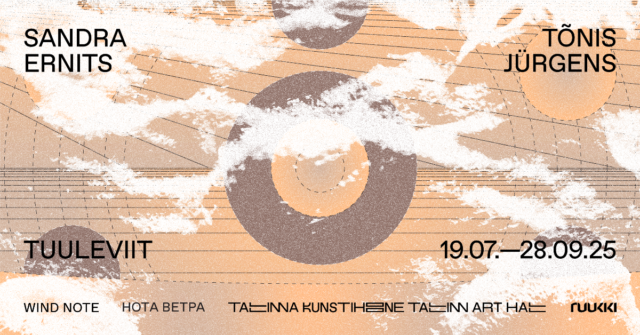THIS SIDE UP, a group exhibition by Liisi Eelmaa (b. 1982) and Minna Hint (b. 1981), was held in the Black Hall of the Sleeping Beauty Castle (Okasroosikese Loss, in Tallinn’s Old Town, 19 Uus Street) on 8 – 15 March.
“Do you not know that there comes a midnight hour when every one has to throw off his mask? Do you believe that life will always let itself be mocked? Do you think you can slip away a little before midnight in order to avoid this?” (Søren Aabye Kierkegaard)
The quote by Kierkegaard was a highlight of the exhibition. From the first sight, a heap of cartons would strike you. Brown cardboard boxes meant for shipment. A video installation of their fluent manufacturing process illustrated the overabundance of these easily accessible, cheap cartons that are lying around everywhere. The machine was making tuk-tuk over and over again, and new cartons were coming forth, one after another, with new boxes folded up ingeniously. At one point, a disruption invaded the clean and perhaps even a beautiful system of manufacturing: leftovers stacked up somewhere; boxes are made by workers who carry identical boxes on their heads. “Factory of Cartons” does not tell us about technical production anymore, it becomes a metaphor of everyday life. Tuk-tuk, the rhythm passes through your body and resonates throughout the exhibition. Tuk-tuk – stop – and here it goes again. Fresh and new cardboard boxes come to replace the old and torn ones. What is the meaning of this system in (the ambiguous) reality?
During the opening hours of the exhibition, the artists were present inside the box-machine to surprise visitors. In a series of staged photographs, the cartons acquire new functionality and therefore a new meaning – they are masks. Each image speaks about the everyday situations at work, at home, in a shop, etc. The artists, putting collage-design boxes on their heads, express the nature of these realistic situations:
If you cannot go hunting, at least you can be a greedy hunter between the shop shelves.
Are there any meetings where you do not feel stupid?
It makes you feel like a chicken cackling in a quarrel.
While being in a strip club, or in any club, is there anything else in your mind than alcohol? Oh – some elements that refer to sexual intercourse.
– And so on.
That’s how masks created by Eelmaa and Hint speak about what we feel underneath the socially-constructed masks. Is this really a case where it is necessary to put a new layer of some kind on everything when there is a will to reflect that which is underneath? Or… (once again) questions along these lines arise: What was at the beginning, what is real? One way to interpret this is to consider an alternative where true feeling and a genuine face are also similar constructs, fabrications, masks just like others. A mask is producing other masks – absurdity and existential angst of the clockwork of life. In this form, there are both the paltriness of the carton and its significance that is produced by itself. If there is nothing under the masks except masks themselves, they abolish their purpose by way of such cornucopia. They do not create a new layer of signification atop something else – which should be their aim. With every layer of simulation, a meaning is created for every situation which adds to the general meaning of the entire compound.
Is there something that precedes this kind of reality? Is there someone or something that produces the cartons and is not a carton? How would the world look like if all the masks were taken off? To quote Minna Hint: “Turns out that it is very hard to get rid of this kind of system of masks. But ought we to? Do we really want to see these sincere and genuine faces?” Of course, maybe there is no need for anything else and it is actually a good solution – the only reality that remains is a factory of cartons without any notions of “before” and “after”. On the other hand, Liisi Eelmaa notes: “The point is – can we actually live ’till the end of our lives without removing these masks?”
What a cliché! And what identification with that cliché! But as one looks for the reason of this identification, a question arises: How does this kind of emphasis come about? The question itself sounds like a cliché. Therefore, is there something real that cannot be feasibly reduced to a cliché? Maybe it is the case when a “cliché” is reduced or elevated to the level of a pre-given model. In the light of this, the whole endeavour could be considered an avowal of courage. There is courage in presenting a cliché in a commensurate treatment of the cliché. Eelmaa and Hint have reflected on this kind of machinery in a simple and a succinct way, where surrealism is the best mode of reflection on realism. Between different levels, there arises an interesting synergy where documentary video and photographs as “realistic reflections” give rise to something that is not revealed by the face of reality while their artificial appendages do expose the so-called genuine reality.
Find the the text in Estonian on Artishok: artishok.blogspot.com
